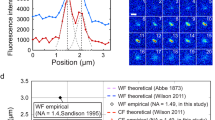Abstract
Purpose
We quantified the performance of time-domain imaging (TDI) and spectral imaging (SI) for fluorescence imaging of quantum dots (QDs) in three distinct imaging instruments: eXplore Optix (TDI, Advanced Research Technologies Inc.), Maestro (SI, CRi Inc.), and IVIS-Spectrum (SI, Caliper Life Sciences Inc.).
Procedure
The instruments were compared for their sensitivity in phantoms and living mice, multiplexing capabilities (ability to resolve the signal of one QD type in the presence of another), and the dependence of contrast and spatial resolution as a function of depth.
Results
In phantoms, eXplore Optix had an order of magnitude better sensitivity compared to the SI systems, detecting QD concentrations of ~40 pM in vitro. Maestro was the best instrument for multiplexing QDs. Reduction of contrast and resolution as a function of depth was smallest with eXplore Optix for depth of 2–6 mm, while other depths gave comparable results in all systems. Sensitivity experiments in living mice showed that the eXplore Optix and Maestro systems outperformed the IVIS-Spectrum.
Conclusion
TDI was found to be an order of magnitude more sensitive than SI at the expense of speed and very limited multiplexing capabilities. For deep tissue QD imaging, TDI is most applicable for depths between 2 and 6 mm, as its contrast and resolution degrade the least at these depths.





Similar content being viewed by others
References
Massoud TF, Gambhir SS (2003) Molecular imaging in living subjects: seeing fundamental biological processes in a new light. Genes Dev 17:545–580
Lee J, Sevick-Muraca EM (2002) Three-dimensional fluorescence enhanced optical tomography using referenced frequency-domain photon migration measurements at emission and excitation wavelengths. J Opt Soc Am A, Opt Image Sci Vis 19:759–771
Godavarty A, Eppstein MJ, Zhang C, Theru S, Thompson AB, Gurfinkel M, Sevick-Muraca EM (2003) Fluorescence-enhanced optical imaging in large tissue volumes using a gain-modulated ICCD camera. Phys Med Biol 48:1701–1720
McCormack E, Micklem DR, Pindard LE, Silden E, Gallant P, Belenkov A, Lorens JB, Gjertsen BT (2007) In vivo optical imaging of acute myeloid leukemia by green fluorescent protein: time-domain autofluorescence decoupling, fluorophore quantification, and localization. Mol Imaging 6:193–204
Kumar AT, Skoch J, Bacskai BJ, Boas DA, Dunn AK (2005) Fluorescence-lifetime-based tomography for turbid media. Opt Lett 30:3347–3349
Arridge SR, Hebden JC (1997) Optical imaging in medicine: II. Modelling and reconstruction. Phys Med Biol 42:841–853
Elson D, Requejo-Isidro J, Munro I, Reavell F, Siegel J, Suhling K, Tadrous P, Benninger R, Lanigan P, McGinty J, Talbot C, Treanor B, Webb S, Sandison A, Wallace A, Davis D, Lever J, Neil M, Phillips D, Stamp G, French P (2004) Time-domain fluorescence lifetime imaging applied to biological tissue. Photochem Photobiol Sci 3:795–801
Cai W, Shin DW, Chen K, Gheysens K, Cao Q, Wang SX, Gambhir SS, Chen X (2006) Peptide-labeled near-infrared quantum dots for imaging tumor vasculature in living subjects. Nano Lett 6:669–676
Li ZB, Cai W, Chen W (2007) Semiconductor quantum dots for in vivo imaging. J Nanosci Nanotechnol 7:2567–2581
Gao X, Chung LW, Nie S (2007) Quantum dots for in vivo molecular and cellular imaging. Methods Mol Biol 374:135–145
Kim S, Lim Y,Soltesz E, De Grand A, Lee J, Nakayama A, Parker J, Mihaljevic T, Laurence R, Dor D, Cohn L, Bawendi M, Frangioni J (2004) Near-infrared fluorescent type II quantum dots for sentinel lymph node mapping. Nat Biotechnol 22:93–97
Cai W, Chen X (2008) Preparation of peptide-conjugated quantum dots for tumor vasculature-targeted imaging. Nat Protoc 3:89–96
Weissleder R, Ntziachristos V (2003) Shedding light onto live molecular targets. Nat Med 9:123–128
Soo Choi H, Liu W, Misra P, Tanaka E, Zimmer JP, Itty Ipe B, Bawendi MG, Frangioni JV (2007) Renal clearance of quantum dots. Nat Biotechnol 25:1165–1170
Keren S, Gheysens O, Levin CS, Gambhir SS (2008) A comparison between a time domain and continuous wave small animal optical imaging system. Medical Imaging, IEEE Transactions on 27:58–63
Lam S, Lesage F, Intes X (2005) Time domain fluorescent diffuse optical tomography: analytical expressions. Opt Express 13:2263–2275
Miller PJ, Hoyt CC (1995) Multispectral imaging with a liquid crystal tunable filter. Presented at Optics in Agriculture, Forestry, and Biological Processing, Boston, MA
Levenson RM, Lynch DT, Kobayashi H, Backer JM, Backer MV (2008) Multiplexing with multispectral imaging: from mice to microscopy. Ilar J 49:78–88
Mansfield JR, Gossage KW, Hoyt CC, Levenson RM (2005) Autofluorescence removal, multiplexing, and automated analysis methods for in vivo fluorescence imaging. J Biomed Opt 10:41207
Godavarty A, Sevick-Muraca EM, Eppstein MJ (2005) Three-dimensional fluorescence lifetime tomography. Med Phys 32:992–1000
Chernomordik V, Gandjbakhche A, Lepore M, Esposito R, Delfino I (2001) Depth dependence of the analytical expression for the width of the point spread function (spatial resolution) in time-resolved transillumination. J Biomed Opt 6:441–445
Acknowledgements
We acknowledge funding support from the National Institute of Health grants NCI CCNE U54 CA119367 (SSG), NCI ICMIC P50 CA114747 (SSG) and the Canary Foundation (SSG). A. de la Zerda thanks the Bio-X Graduate Student Fellowship and the DoD Breast Cancer Research Program - Predoctoral Traineeship Award for partially supporting this work.
Author information
Authors and Affiliations
Corresponding author
Rights and permissions
About this article
Cite this article
de la Zerda, A., Bodapati, S., Teed, R. et al. A Comparison Between Time Domain and Spectral Imaging Systems for Imaging Quantum Dots in Small Living Animals. Mol Imaging Biol 12, 500–508 (2010). https://doi.org/10.1007/s11307-009-0290-4
Received:
Revised:
Accepted:
Published:
Issue Date:
DOI: https://doi.org/10.1007/s11307-009-0290-4




